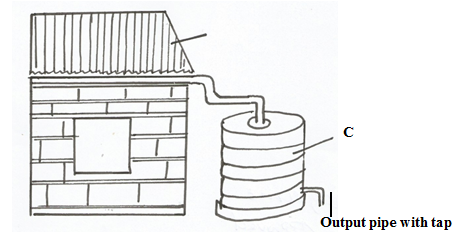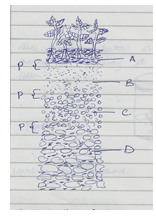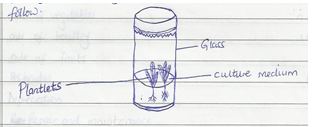INSTRUCTIONS TO CANDIDATES:
- This paper consists of THREE sections A, B and C.
- Answer ALL questions in Section A and B.
- Answer any TWO questions in section C.
- Candidates should check the question paper to ascertain that all the pages are printed as indicated and no questions are missing.
SECTION A 30MKS
- Define the term shifting cultivation 1mks
- Differentiate between organic farming and agro forestry.2mks
- Differentiate between fodder crops and pasture crops (2mks)
- State four factors determining the quality of tomatoes.2mks
- List three main ways in which pasture crops can be classified (11/2mks)
- Define the term soil erosion (1mk)
- Distinguish between a dam and a weir (1mk)
- State 4 benefit of agriculture to our economy. 2mks
- Give 4 advantages of tissue culture 2 mks
- State properties of soil that are influenced by its texture.2mks
- State four post harvest practices carried out on maize grain 2mks
- Outline government policy that regulate amount of imported good.2mks
- Give importance of sub soiling.2mks
- Name three types of surface irrigation
- Give Four advantages of sub-surface irrigation (2mks)
- Outline 4 factors determining number of secondary cultivation when preparing a seedbed. (2mks)
- Give 4 factors affecting herbicides selectivity (2mks)
SECTION B (20 MKS) - The diagram below shows a structure used to collect water in the farm.
- Identify the method of water harvesting above (1mk)
- Give two factors that will determine the amount of water collected from the above mentioned structures. (2mks)
- Outline one maintenance practice that should be carried out on part labeled c above. (1mk)
- Name one other method used to collect water in the farm. (1mk)
- Describe the procedure of sampling soil for testing. (5mks)
- The diagram below illustrates a feature observed after digging the soil several metres deep Study the diagram carefully and answer the question that follow
- Identify the feature that the diagram above represents in the study of soil (1mrk)
- What is the name given to the part labeled p(1mrk)
- Give a reason why part b is also reffered to as layer of accumulation (1mrk)
- State two ways in which the knowledge of the above feature would be of benefit to farmer(2mrks)
- The diagram below shows a method of crop propagation .Study it and answer the questions that follow
- Identify the method (1mrk)
- Name two crops that can be propagated using this method.(2mksmrk)
- Give two ingredients used when preparing the above activities.(2mks )
SECTION C 40 MKS(ANSWER ANY TWO QUESTION IN THIS SECTION)
-
- Outiline four Importance of treating water (4mks)
- Explain four factors influencing crop rotation. (8mks
- Explain Factors influencing soil erosion (8mks)
-
- Explain Importance of drainage as a land reclamation method (10mks)
- state reasons for carrying out minimum tillage (5mks)
- Outline Factors determining the quality of farm yard manure (5mks)
-
- Describe planting of carrot under the following subheadings
- Planting (5mks)
- Field management (5 mks)
- Outline Importance of organic matter.(5mks)
- State Four benefits of soil structure in crop production. (5mks)
- Describe planting of carrot under the following subheadings

MARKING SCHEME
- Define shifting cultivation 1mks
-it is the farming on a piece of land continuously until it is exhausted after which the farmer shift to a more fertile land
- Differentiate between organic farming and agro forestry.2mks
- Organic farming farming is growing crops and rearing of animals without use of chemicals while agro forestry is growing of crops, planting of trees and rearing of livestock on the same piece of land. 2mks
- Differentiate between fodder crops and pasture crops (2mks)
-Fodder crop –these are forage crops which are grown , allowed to mature ,then cut and given to livestock as feed
-Pasture crop-these are forage crops harvested directly by livestock through grazing
- State four factors determining the quality of tomatoes.2mks
-size of fruits
-degree of ripeness
-damage of tomatoes by pest
-Shape of fruit
- List three main ways in which pasture crops can be classified (11/2mks)
-According to the pasture stand
- According to pasture establishment
-According to the ecological zones /altitudes
- Define the term soil erosion (1mk)
-Soil erosion is the process by which the soil is detached, removed and carried away from one place to another where it may not be useful
- Distinguish between a dam and a weir (1mk)
-A dam is a wall or a barrier built across a river or a dry valley to collect water and hold large volumes of water while weir is barrier constructed across a river to raise the volume of water level and still allow the water to flow over it.
- State 4 benefit of agriculture to our economy. 2mks
-Food supply
-Source of employment
-Provision of foreign exchange
-Source of raw materials for industries
-Source of market for industrial goods
-Source of money or capital - Give 4 advantages of tissue culture 2 mks
-Mass production of propagules
-Establishment of pathogen free plants
-Require less space
-Possible to propagate crops that have no viable seeds
Maintain the genetic potential of plants
- State properties of soil that are influenced by its texture.2mks
-water holding capacity
-aeration
-drainage
-capillarity
-fertility
- State 4 post harvest practices carried out on maize grain2mks
-drying
-processing
-Threshing/shelling
-sorting and grading
-winnowing/cleaning
-application of pesticides/dusting
- Outline government policy that regulate amount of imported good.2mks
-heavy taxations of imports
-giving subsidy
-quality control
-conservation of natural resources
-stepping up control of disease pest and parasites
- Give importance of sub soiling.2mks
-breaking the hardpan
-Improves aeration/facilitates gaseous exachange
-facilitate root penetration into the soil
-improves water infiltration
-exchange in the soil brings to the surface minerals which had been leached to the deeper layers - Three types of surface irrigation (11/2mks)
-furrow irrigation
-flood irrigation
-Basin irrigation - Four advantages of sub-surface irrigation (2mks)
-Economizes the use of water
-it can be practiced on both slopy and flat land
-minimizes possible theft of pipes
-fungal diseases such as blight are reduced because water does not accumulate on leaves
-minimizes labour requirement - Outline 4 factors determining number of secondary cultivation when preparing a seedbed.2mks
-condition of the land
-type of implement available
-type of soil
-size of planting material
-tilth required
-moisture content in the soil
- Give 4 factors affecting herbicides selectivity2mks
-age of weeds
-plant morphology
-chemical concentration
-stage of growth
-rooting system
-Environmental factors
SECTION B (20MARKS) -
- Roof catchment (1 x 1 = 1mk)
- – Rainfall intensity
- Duration of rainfall
- Surface area of the roof
(2 x 1= 2 mks) - – repair the leaking parts
- Regularly wash and remove the sediments
- Paint the iron sheet tank to control rusting.
(1 x 1 = 1 mk) - - Ponds, Drums
(1 x 1 = 1mk) - Procedure for soil sampling 5MKS
- Clear the vegetation
- Make a vertical cut to 15 cm to 30 cm for crop land or 5 cm for pasture land.
- Take a slice from the vertical cut or use a soil anger to scoop out the soil.
- Put the soil in a clearly labelled polythene bag.
- Repeat the above procedure in a different locations according to the method of sampling.
- The diagram below illustrates a feature observed after digging the soil several metres Study it carefully and answer the questions that follow.
- Soil profile(1mrk)
- Transitional zone (1mrk)
- Because sometimes minerals are leached from the soil and accumulate in the layer b (1mrk)
- Ways in which the knowledge of the above feature would be of benefit to a farmer(2mrks)
-Decides what crop to grow
-How best to cultivate the land
-
- Tissue culture 1mks
- Banana& passion fruits 2mks
- Two ingredients used when preparing tissue culture
-Sugar (2 mrks)
-inorganic minerals
-Vitamins
-Organic supplements
-Growth regulators
SECTION C 40 MKS (ANSWER ANY TWO QUESTIONS IN THIS SECTION)
- Importance of treating water (4mks)
-To kill disease causing micro-organisms I .e .cholera and typhoid bacteria that thrives in dirty water.
-To remove chemical impurities such as excess fluoride this may be harmful to human beings.
-To remove smells and bad taste /unfit for human consumption
-To remove sediments of solid particles such as soil, sand, and sticks to make water clear.
-To soften the water - The four factors influencing crop rotation. (8mks)
-Crop root depth-Deep rooted crop should be alternated with shallow rooted when designing a crop rotation programme.
-Crop nutrients requirement-Heavy or gross feeders should come first in a newly opened land which is relatively fertile.
-Weed control -Crops which are associated with certain weeds should be alternated with those are not
-Pests and diseases control. Crops from the same families should not follow one another in the rotation programme as they are attacked by the same pests and diseases
-Soil fertility -.Leguminous crops should be included to improve soil fertility
-The soil structure-When the soil is used continuously it becomes loose and pliable, grass should be included to in the soil structure - Factors influencing soil erosion (8x1=8mks
- The amount and intensity of the rainfall
Heavy rainfall hit the ground with a force that the soil is splashed up with the water - The type of soil
The ability of water to infiltrate into the soil depends on the soil type .Sandy soil get saturated quickly than clay soil which is more resistant to water erosion - The slope of the land (topography)
Speed of the water as it flows is determined by the slope of the land - Soil depth
Shallow soils becomes saturated with water very quickly and are easily eroded - Vegetation cover
Forest protect the soil against erosion because the trees act as barriers, preventing direct exposure of the agents of erosion - Overstocking
When an area is overstocked by cattle ,sheep or goats the soil cover is destroyed due to over grazing leaving the soil surface bare .Surface is easily eroded by rain water during the rainy season - Deforestation
It is indiscriminate removal of trees from forested areas hence exposing soil to both high temperatures and heavy rainfall - Planting of annual crops on steep slopes
This leads to frequent cultivation hence exposure of soil to soil erosion - Indiscriminate burning of vegetation before cultivation
The land is left exposed to the erosive forces of rain and wind - Clean weeding
This leaves the soil more or less unprotected against water erosion - Ploughing up and down the slope
- The amount and intensity of the rainfall
- Importance of treating water (4mks)
-
- Importance of drainage as a land reclamation method 5x2=10mks
-To increase soil aeration-excess water around the root zone retards plant growth because it fills the air spaces restricting air movement.
-To increase soil volume-the amount of soil around the root zone from which the roots can easily get nutrients is increased.
-To raise soil temperature-it improves the rate at which soil warms up for better plant growth.
-To increase soil microbial activities- micro-organisms increase in number due to the proper aeration. They help to improve soil structure and make food more readily available.
-To reduce soil erosion-well drained soil have high water holding capacity which help to reduce run-off and increase infiltration rate.
-To remove toxic substances-due to water logging, soluble salts such as those of sodium increase in concentration to levels that are toxic to plants or may retard growth. - Reasons for carrying out minimum tillage (5mks)
-To reduce the cost of cultivation or ploughing by reducing the number of operations.
-To control soil erosion .Mulching and cover cropping greatly reduce chances of soil erosion.
-To maintain soil structure .continuous cultivation destroys soil structure hence it is avoided.
-To conserve moisture .continuous cultivation exposes the soil to the heat of the sun thus enhancing evaporation of available moisture
-To prevent the disturbance of the roots and underground structure e .g tubers and bulbs.
-To prevent exposure of humus to adverse conditions such as the sun’s heat that causes volatilizations of nitroge - Factors determining the quality of farm yard manure (5=5mks)
- Type of animal used—dung from fattening animals has a higher level of nutrients than that from dairy animals/non ruminants I .e pig and poultry absorb less nutrients from their feed hence give dung which has a higher level of nutrients.
- Type of food eaten-feedstuffs that are highly nutritious results in manure with a higher level of nutrients
- Type of litter used-farmers are advised to use litter with high urine absorption
- Method of storage-farm yard manure must be stored well preferably in a place with a leak-free roof and a concrete floor. This prevents loss of nutrients through leaching and vaporization by action of rain and heat respectively.
- Age of the farmyard manure
- Importance of drainage as a land reclamation method 5x2=10mks
-
-
- Planting carrot
- Make continuous drills 30 – 40 cm apart.
- Apply DSP in the drills at the rate of 90 kg/ha.
- Mix the fertilizer well with the soil.
- Place the seeds in the drill at the rate of 5 – 6 kg/ha
- Cover the seeds lightly, then carry out rolling.
(5 x 1 = 5mks) - Field Management
-Thin two weeks after germination to attain a distance of 5 cm – 8 cm.
-Keep the field free of weeds
-Earth up during weeding
-Top dress with CAN at 60 kg/ha
-Carry out irrigation during dry conditions.
-Control pests and diseases using appropriate chemicals.
(5 x 1 = 5 mks)
- Planting carrot
- Importance of organic matter.
- Prevents nutrients leaching
- Reduces toxity of the soil.
- Improves soil fertility when they decompose and release nutrients
- Encourages microbial activities
- Improves water infiltration and retention capacity.
- Moderates/buffers soil P.H by preventing rapid chemical changes. (5 x 1 = 5mks) - Four benefits of soil structure in crop production.5mks
- Hold more moisture for crop production.
- Well drained/have better infiltration.
- Allow better root and tuber expansion.
- Allow better root penetration for nutrients and moisture uptake.
- Allow plant anchorage
-
Download AGRICULTURE PAPER 1 - 2019 KCSE CEKENA MOCK EXAMINATION (QUESTIONS AND ANSWERS).
Tap Here to Download for 50/-
Get on WhatsApp for 50/-
Why download?
- ✔ To read offline at any time.
- ✔ To Print at your convenience
- ✔ Share Easily with Friends / Students




